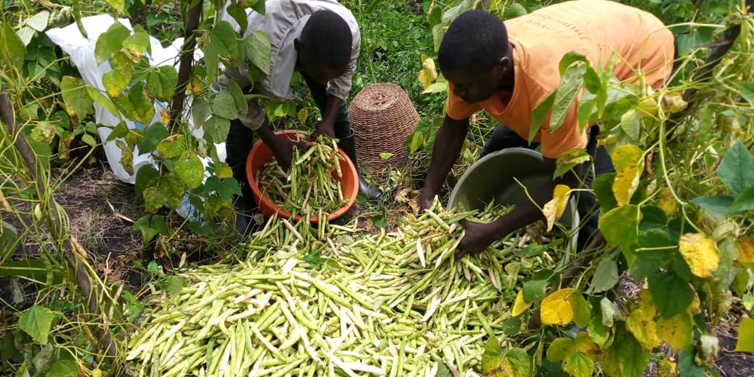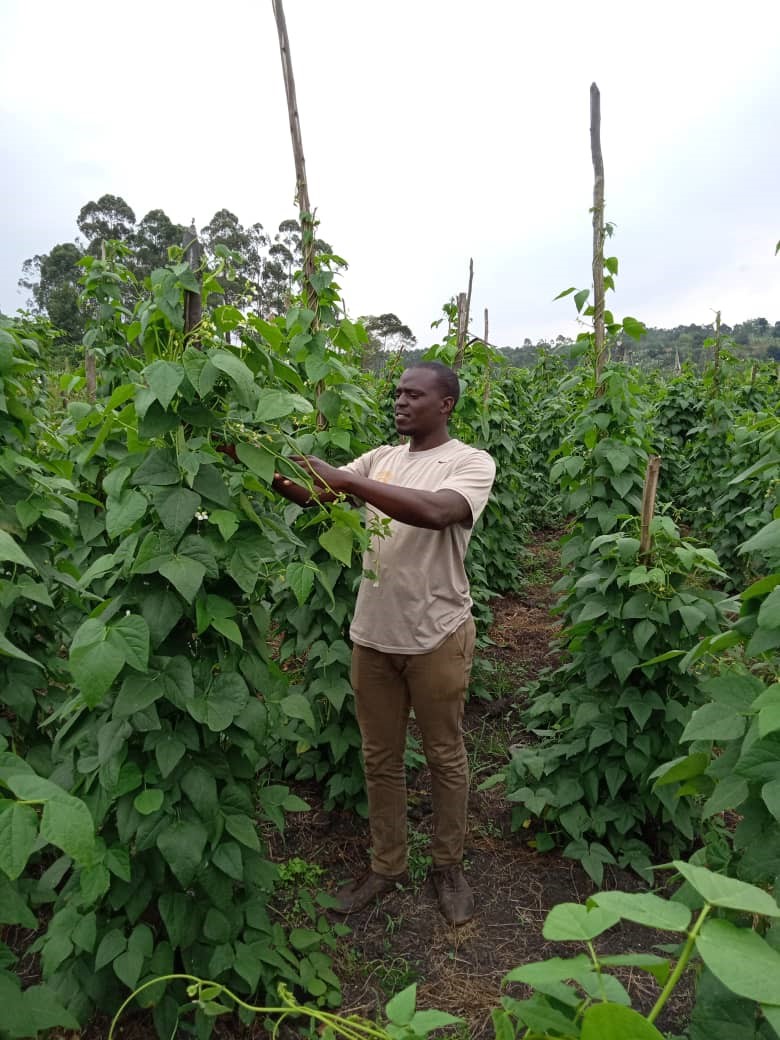By Charles Katabalwa (CEDO), Gabrielle Birwa Luyima (NARO), Patricia Onyango, Owen Kimani, Eileen Nchanji, Justin Machini, Jean Claude Rubyogo
Fresh pod beans are becoming a popular source of protein among urban dwellers in Uganda. They are considered highly nutritious and cook faster compared to dry beans. Depending on the variety planted, the expected yield is between 100 -150 bags per season from a two-acre piece of land. Large scale fresh bean growing takes place in Central Uganda with NABE 12c bean as the most commonly grown bean type because of its climbing nature and can be grown in a small piece of land.
The biggest production areas for fresh pod beans in Uganda are in Masaka, Kabale, and Mbale. Most of the beans once harvested are sold in Kampala, Jinja, and Mukono. Traders as far as Nakasero, Usafi, and Owino markets offload fresh pod beans daily for their consumers. The business is booming with traders offloading over 150 bags daily and all are sold out.
For 24-year-old Kisekka Junior, who lives in Masaka District with his family of six, growing beans was a remarkable coincidence. Immediately after he graduated with a Bachelor of Science degree in Agriculture, he approached the Community Enterprises Development Organisation (CEDO) for post-university work experience. He yearned to put the technical and theoretical knowledge he had gained into practice. The practical exposure he received from CEDO was enough to convince him to start farming, a venture he had not put much thought into. “When I was young, the closer I got to agriculture was growing tomatoes at home and selling to neighbors to collect enough for school fees and my upkeep. However, with CEDO, I got practical lessons on producing beans using good agronomy practices,” he said.
When the prices of tomatoes started fluctuating, Kisekka decided to stop growing them. “Continuous price changes, uncertainty in the market, improper standardization procedures to measure tomatoes like using tins, basins, and baskets was discouraging.” He explained. He further laments that tomatoes were often affected by pests and diseases like tomato blight, which resulted in a souring debt of UGX 2,300,000 (US$ 630) in one of the seasons.
Kisekka got himself at crossroads, wondering what direction to take in terms of setting up an enterprise. He considered a business that would require less capital to set up, not time-consuming with little management on his part, with a ready market. He also wanted a business venture that would have benefits to his community offering nutritious food and as well as creating employment to the youth around him. Out of the crops he considered, he choose beans. He chose beans because he felt it fit his criteria perfectly. In his first season, he planted 35 kilos of NABE 4, a bush variety in his one-acre piece of land. The first harvest was good. He got 12 bags of fresh pod beans and sold each bag at UGX: 100,000 (US$ 27); making US$ 324. He made a profit of US$ 297. “I invested UGX 250,000 (US$ 67) on land preparation, planting, weeding, and harvesting, and I got the money back plus more. “ he explains excitedly. The market for the fresh pod is not yet structured, the buyers either use basins, baskets, tins, or bags and ensure they fill them to the brim. The approximation kilograms of the fresh pod in the bag is between 90kg to 100kg. The marketing process is not standardized yet.
When interacting with other sellers and exchanging information on beans, he stumbled upon climbing beans. “I heard very good things about climbing beans; they fetch better farm gate prices that is three folds with yields up to four times higher than those of the bush type,” he said. The most recommended climbing bean variety was NABE 12C popularly known as Masavu or Nabudaama. Compared to other crops like tomatoes, climbing beans required little initial capital investment, affordable management practices, and the stakes used can be recycled up to four times in the subsequent cropping season.” he added
Compared to the bush beans he grew in the first season, where he got UGX 412,000(US $110); The difference in the amounts is due to deduction of the operating costs when he decided to switch to growing the climbing beans, the following respective seasons his sales grew to UGX 4,658,000 (US$ 1,246) and UGX 3,588,000 (US$ 960) respectively.
“My biggest challenge about growing climbing beans is getting the seeds for optimal production. Also, despite the popularity of fresh podded beans, the market is full of brokers who buy the green beans cheaply at the farm gate, and sells at a higher price in the market. ‘’ he laments.
‘’Getting a financial boost from financial institutions is still a challenge. Very few banks have credit products for farmers, which will go a long way in boosting agricultural productivity.” He adds.
Kisseka wants to seek more guidance on producing climbing bean seeds to fill the gap of limited access to viable seeds of the beans. He also wants to establish a roadside market stall that packages the beans in a presentable manner, as opposed to heaping and using tins/baskets.
To help him get to the market easily, Kisseka recently bought a motorcycle worth UGX 5million (US$1,336 ) to transport his beans to the market which is 25 kilometers from my village, to get a better price. He has employed eleven people, comprising of 2 male workers and 9 female workers from his community, who support weeding and harvesting. Kisekka also boasts of supporting his brothers through school. Besides working at his farm, the employed workers have also established their own bean gardens adopting the bean growing practices they learn at Kisekka’s garden. Through the beans they grow, they sell and use the money to meet their basic household requirements. Within the community, over 150 households have taken up growing climbing beans because of Kisekka’s influence. Two of his farm employee are paying school fees for their children from the income received as farmhands.
Kisekka’s triumph in the production of climbing beans has seen him venture into other agricultural activities of poultry farming, where he rears 1000 broiler birds. The income from the chicken sales supplement his beans sales. The poultry farm also provides organic manure to his farm.


